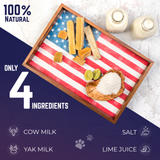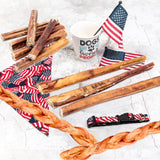Have you ever wondered how your furry friend feels in the cold months of winter? As dog owners, we all want the best for our canine companions. But, sometimes, the information out there can be a mishmash of truths, half-truths, and, let’s face it, downright myths. Like the game of "Telephone" we played as kids, some of these beliefs have been passed down from generation to generation, altering slightly with each retelling.
The world of dog care, especially in winter, is rife with misconceptions. Have you ever heard the one about dogs being just fine in freezing temperatures because they're dogs? Or that our four-legged friends can happily munch on snow when thirsty? Let's navigate this chilly terrain together, debunking some common winter dog myths.

The Origin of Winter Dog Myths
Historical beliefs and practices, combined with pop culture, have led to common misconceptions about dogs and their abilities to withstand the cold weather. In the past, dogs were primarily used for work, such as hunting and guarding, and were often believed to be naturally resistant to the cold. However, such beliefs are not entirely accurate, and dogs are susceptible to the cold, just like humans.
The influence of pop culture, including movies and literature, has also contributed to the belief that all dogs are winter-hardy. It's essential to understand that our furry friends have varying cold tolerances, and some breeds are more equipped to handle the cold than others. As responsible dog owners, we must be aware of the potential risks and take appropriate measures to ensure our dogs stay warm and comfortable during winter.
One of the ways dog breeds differ is in their coats. Some breeds have double coats, which means they have an extra layer of insulation to protect them from cold weather. On the other hand, single-coated breeds lack this added insulation, which means they might not be as well-equipped to handle Jack Frost's visit. So, while you might envy your friend's thick winter coat, remember that not all dogs are equally equipped to handle the cold.
Myth#2: Dogs Don’t Need Winter Outfits
Another way to protect your dog during winter walks is by using booties. Just like walking barefoot on icy roads sprinkled with salt can be painful for humans, it's even worse for dogs. Wearing booties can shield your dog's sensitive paws from the harshness of winter streets, ensuring those fun walks remain just that – fun! So, remember to prioritize your dog's comfort and safety during the colder months.
Myth #3: Dogs Can Eat Snow Instead of Drinking Water
Myth #4: If a Dog's Tail is Wagging, It’s Not Cold
Myth #5: Winter Walks are Unnecessary
However, we understand that winter weather can be harsh, and not all days are suitable for taking a stroll. In those instances, you can consider indoor playtime, short yard games, or even doggy treadmills to keep your pet active. Being flexible with your pet's exercise routine is key to ensuring they maintain their physical well being even during the winter months.
Myth #6: Dogs Can't Get Frostbite
Symptoms of frostbite in dogs include pale or cold skin, swelling, and pain. If you suspect that your dog is suffering from frostbite, it is crucial to seek veterinary help immediately. Remember, frostbite can cause permanent damage to your dog's skin and tissue.
To prevent frostbite, ensure that you limit your dog's exposure to extreme cold weather. Additionally, always remember to dry your dog off after a snowy outing. In case your dog is suffering from frostbite, never use direct heat. Instead, use warm (not hot) water to help thaw the affected areas and seek veterinary guidance as soon as possible.
Myth #7: Dogs Can Sleep Outside All Winter Long
If your furry friend spends a lot of time outside during the winter months, it is important to provide them with a well-insulated dog house that is raised off the ground and has a wind-blocking entrance. This will help keep them protected from cold drafts and prevent the accumulation of snow and ice. However, on particularly cold nights, it is highly recommended to bring your dog inside for a cozy snooze.
Remember, providing your dog with a warm and comfortable place to sleep is crucial to their overall health and well-being. By taking the necessary precautions, you can ensure that they stay healthy and happy throughout the winter season.
Myth #8: Antifreeze is Safe Since Dogs Love It
Antifreeze is a common household item we use to keep our cars running smoothly. However, it can be extremely dangerous to our pets, especially dogs. Even a small amount of antifreeze can be lethal for them because they are naturally attracted to its sweet taste.
To keep our pets safe, we can use pet-safe antifreeze products that are specifically designed to be non-toxic for animals. Additionally, we should store antifreeze products out of reach of our pets and clean up any spills or leaks immediately.
By taking these simple preventive measures, we can avoid any unfortunate incidents and keep our furry friends safe from harm. As pet owners, it is our responsibility to ensure that our pets stay healthy and happy.
The Dangers of Spreading Myths
Spreading myths about winter can have dire consequences for dog health and wellness. Myths such as "dogs don't need sweaters in winter" or "dogs can eat snow instead of drinking water" can lead to serious health problems in dogs, such as hypothermia, frostbite, dehydration, and kidney problems. Spreading these myths can also lead to dogs being surrendered to shelters or euthanized unnecessarily.
Responsible dog ownership plays a crucial role in preventing the spread of winter myths about dogs. It is our responsibility to educate ourselves about our dogs' needs, behavior, and health, and to dispel any myths we encounter. This includes providing our dogs with proper winter gear, such as sweaters and boots, if necessary, and ensuring that our dogs have access to clean water at all times. By educating ourselves and others, providing proper care and treatment for our dogs, and spreading accurate information, we can help ensure the health and well-being of our furry friends and prevent the spread of harmful winter myths.






